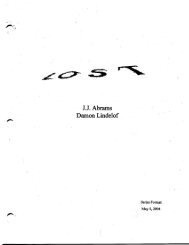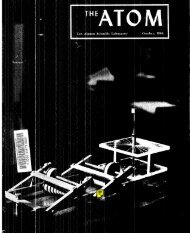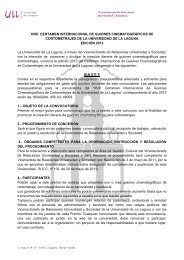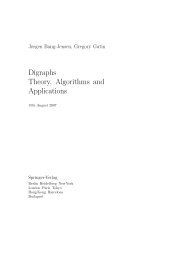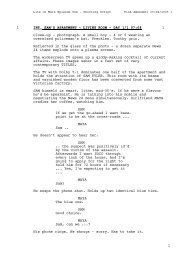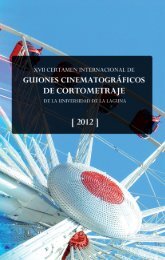You also want an ePaper? Increase the reach of your titles
YUMPU automatically turns print PDFs into web optimized ePapers that Google loves.
possible value of the coefficient of<br />
friction, we assume that the rod has<br />
been pressed very strongly and,<br />
hence, the force mg car be neglected.<br />
Then<br />
Ncoso:IsincrCotO( ' --r--I.<br />
u2 \12<br />
We've obtained the answer, but<br />
some comments are in order. If J ><br />
2R, we can't insert the rod into the<br />
dome. If, on the other hand, the rod<br />
is too small, then the corresponding<br />
value forp will be too large and will<br />
make no sense. Finally, rubber is a<br />
substance with very complicated<br />
properties; its i_nteraction with a<br />
solid surface is not adequately described<br />
by the laws of dry friction<br />
(but that's another story).<br />
P1 18<br />
The conduction of heat from the<br />
inner shell of the thermos (that is,<br />
from the tea) is performed by molecules<br />
of gas between the inner and<br />
outer shells. That's why the space<br />
between the shells was pumped out:<br />
to prevent the gas that remains from<br />
forming a continuous heat-conducting<br />
medium-that is, to make the<br />
molecules move between the shells<br />
without colliding with one another.<br />
Let's assumethat after a collision<br />
with a shell, a molecule on average<br />
has an energy proportional to the<br />
temperature of the shell. Thus, at<br />
the outer shell the kinetic energy of<br />
the translational movement of a<br />
molecule is K, - %kTr, where { is<br />
room temperature; at the inner shell<br />
the corresponding value is K, -<br />
"/zkT, where 7, is the temperature<br />
of the tea. Although this temperature<br />
changes with time, the range of<br />
its variation is not large: AT = 363 K<br />
- 343 K = 20 K. So for the purpose of<br />
our estimates we can assume thatKl<br />
- %kT"where 7. = 353 K is the average<br />
temperature of the hot shell.<br />
Consequently, after a coliision<br />
with the hot shell, each molecule<br />
"takes" energy from the tea that is<br />
equal to<br />
LK - %kff"- T,l.<br />
The number of molecules colliding<br />
with the hot shell per unit time is<br />
proportional to f nvs, where n is<br />
the density of the gas molecules and<br />
v is the average magnitude of the velocity<br />
projected perpendicular to the<br />
wall. The number of molecules<br />
that collide with the wall during<br />
time At is<br />
N - fnvSLt.<br />
These molecules take from the tea<br />
the energy<br />
AE : NAK - sfnvSk(T"- T,lLt.<br />
This energy is equal to the change<br />
AU in the intemal energy of the tea<br />
in the period At-that is, AE : LU.<br />
Insofar as<br />
LU: McLT,<br />
where AT is the change in the temperature<br />
of the tea, then<br />
sfnvSk(T"- T,lLt - MILT.<br />
From this we get<br />
4McLT<br />
Af-:<br />
ȧnvsk(4 -4)<br />
Taking into accountthat v - $fli,<br />
where p is the molar mass of the gas,<br />
and n: PlkT, (which follows from<br />
the Clapeyron-Clausius equation),<br />
we finally obtain<br />
Lt-<br />
aMcLf<br />
rE\<br />
BP(4 - 4)sJR<br />
Substituting numerical data lM :<br />
1 kg, A7:}OIK,T,=293K,P: lPa,<br />
p.= 29 . 10-3 kg/mol, and so on)<br />
results in<br />
Lt-3.104s-gh.<br />
P1 19<br />
At an arbitrary point A at a distance<br />
R from the wire, the velocity<br />
of the particle is directed at a small<br />
angle cr with the x-axis, so<br />
Figure 7<br />
where v, is the vertical projection of<br />
the velcicity and v, : TXlmis the<br />
horizontal projection.<br />
Let's write down Newton's second<br />
law for the y-component (fig.7l:<br />
where<br />
v<br />
A= -, v<br />
Fydt = mdvr,<br />
F, = gEc'ssy = e),cosy<br />
ZneoR<br />
The small time period dt canbe derived<br />
from the formula v,= dxf dt:<br />
,dx<br />
uL -<br />
v x<br />
Rdv<br />
Y COSTI,T<br />
xr<br />
During this time the vertical projection<br />
changes by<br />
F. e),,<br />
dv..<br />
o =<br />
Jdt = ----"!' 4*.<br />
m 2neomv,<br />
The total projection of the velocity<br />
on the y-axis is composed of small<br />
increments:<br />
'<br />
rl2<br />
-^,' ' Zeomv*<br />
Thus, the angle we're seeking is<br />
d=L<br />
v, e?" e)"<br />
_<br />
=<br />
v, 2eomtl 4eoK<br />
P120<br />
Two cases are possible. (1) The<br />
lens is convergent. Drawing the<br />
0lJAitIUil/AitstItR$, ililllT$ & $0t l|Tt0its 5l



